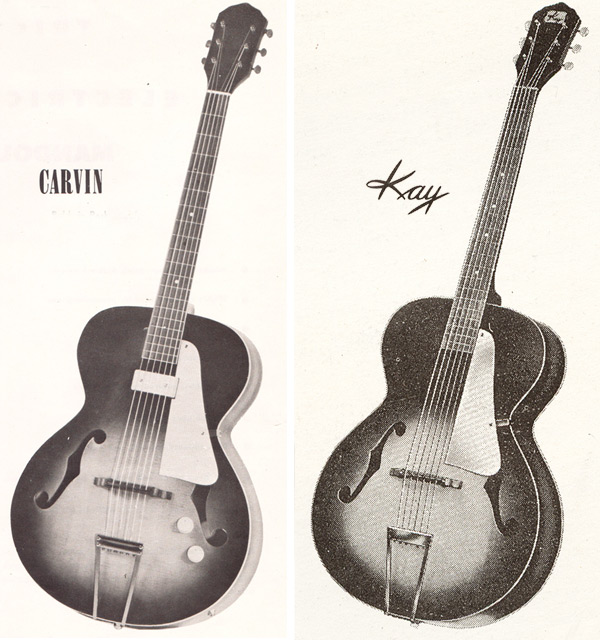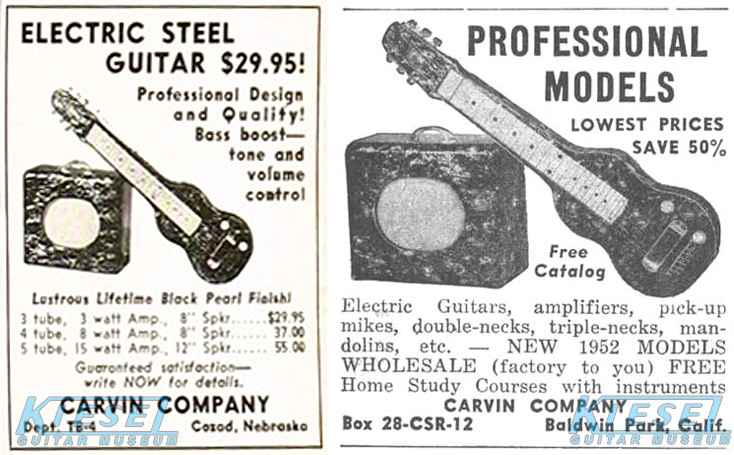
The logos on the left were used by Kiesel in the earliest years of the company. Briefly, instruments were badged with a Gothernburg, Nebraska logo, prior to Lowell Kiesel's move to southern California, and the adoption of the Los Angeles logo. Following the company rebranding to Carvin, the two logos at the bottom were used in the early 50s on instruments and other gear. The top logo was used on steel guitars; the bottom logo was probably used exclusively on Spanish guitars (as they were generally referred to at the time), as these instruments of the era generally had a more ornate headstock. Variants of the top logo would also be used after the move to Covina, but with a less fanciful font.
Carvin offered a handful of "Spanish" electric guitars in the early 1950s. These were most likely
made by Kay, Hofner or some other manufacturer, and then badged with the Carvin logo and equipped with a Carvin AP pickup. The Model 140 Spanish electric was a
single-pickup arch-top model, with a spruce top, and rosewood fingerboard and bridge. It had white binding on the front and back, and a
white pickguard, and a single A-Series pickup with volume and tone controls. The finish was antique brown. It was also available as the
Model 1744, which was a non-electric version. The Model 140 sold for $59.90, and the Model 1744 sold for $36.90. The case for either was an additional $9.90.
This model would be offered until 1959. Compare the Model 140 (left) with Kay's Model K-34 below. See the entire Kay flyer in the gallery above (the Kay flyer wasn't distributed by Carvin; it's included
here for information purposes).

In the gallery at the top of the page, note the July 1954 Popular Mechanics. Carvin had a small ad in the back of this issue (see enlarged image in the gallery). This
was one of Carvin's earilest advertising mechanisms, mixed in with other assorted (and sometimes comical) ads of the era. The ad below (right) is from 1952, but the source is unknown. However, it does mention
a "Free Catalog", so it's possible that catalogs prior to 1954 - the first known catalog - do, or at least did, exist. The ad on the left is from 1949, and represents one of the
oldest examples of Carvin advertising known. The original source of this ad is unknown, but it was from an interesting time in Carvin's history, when Lowell Kiesel operated the company from Cozad, Nebraska,
near his birthplace of Eustis, Nebraska, before moving to California.

A variety of models would bear the name "Student Deluxe" in Carvin's steel guitar lineup throughout their formative years. In the early 50's, it was the Model #22. This was a 22.5" scale no-frills 6-string, with a plastic-covered hardwood body, single pickup with volume and tone controls, basic tuners, and basic bridge/tailpiece. The model #22 sold for $27.50.
The Student Deluxe Model #19 was most likely intruduced in 1953, and an identical model with the same name appeared in the 1954 catalog, although it no longer carried the "Student Deluxe" name. This was a basic lap steel, with a plastic covered hardwood body, and a 22 1/2" scale fingerboard that was probably some type of plastic. Other features included a single pickup with chrome plated cover and single volume and tone controls. The Model #19 sold for $27.50, and the optional case was $6.50 - slightly less than the 1954 pricing, which is more evidence that this is probably a 1953 model.
The Model #50 (shown in the gallery above) and Model #60 steel guitars were similar to the Student Deluxe models, but with upscale features such as ivory knobs and tuner buttons. Like the model #22, it was constructed from premium hardwoods, then coasted with a pearlescent plastic. Like other models of this era, the pickups were not specified, other than that they used Alnico V magnets. The 6-string Model #50 sold for $49.90, and the 8-string Model #60 sold for $65.50.
The Model #59 tripleneck from the early 1950s was a bit of an anomaly. Carvin made several tripleneck (and even quad-neck) steel guitars in the 1950s, but this was the only one that was coated with the same gray pearlescent plastic used on the lap steel models. This was also an 8-string model - possibly Carvin's first. It featured ivory tuning pegs and knobs, 22 1/2" Lucite fingerboards and chrome hardware. It sold for $169.90, and the optional Number 5 Hi-Lo stand was an additional $19.50. In a precursor to today's engraved truss rod cover option, for an additional $12.50, you could have you name stenciled on the side.
The 1953 Model #591 tripleneck had the more standardized rectangular shape Carvin would use on steel guitars throughout their availability (unlike the Model #59, which had a more hybrid style headstock design). It had a maple body, with a mother-of-pearl covering; most likely Bakelite or a similar plastic material. The fingerboards were Lucite. Direct price on the Model 591 was $169.90. By the time the first official Carvin catalog was produced in 1954, this model would be gone.
The Model #2 doubleneck, like other Carvin lap steels of the era, was covered in a gray metallic pearl plastic finish, with a plastic fingerboard. One of the more unusual features of this model was the headstocks - almost all lap steels of the era, regardless of manufacturer, had 3 X 3 or 4 X 4 headstock (for 6 or 8 string), but the Model #2, which was an 8-string, and the Model #16, which was a six-string, had opposite-facing inline headstocks. Other features include volume and tone controls, ivory tuners, and chrome hardware. The page shown above for the Model #2 in the gallery above was included as loose-leaf inserts in a Kay Guitar catalog from the Ed Sale Guitar Company in Bradley Beach, New Jersey, circa 1953. This would suggest that one of Carvin's early methods for reaching new customers was to partner with other resellers, much the same as the way Carvin sold Fender and Martin guitars in their early history.
Even early in their history, Carvin offered mandolins, which was quite a popular instrument at the time. Like the Model #140 guitar, the Model #41 mandolin didn't explicitly use Carvin AP pickups, and judging by the photo, these were not AP-series pickups, but most likely A-series non-adjustable pickups, or a predecessor. The Model #41 was made with an arched birch top and birch back with natural finish, but the neck and fingerboard material were not specified. The Model #41 electric mandolin sold for $49.90.
One of the more unusual aspects of Carvin's early history is that they offered accordions. These were not made by Carvin, but were most likely made by Sonola as stated in later catalogs, or by Capri (as shown in the 1959 catalog) or some combination of the two, and maybe other manufacturers. It's not clear if they were Carvin-badged, but most likely, they were not. Regardless, it's an interesting footnote in Carvin's long history.